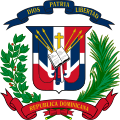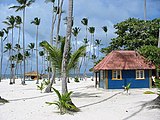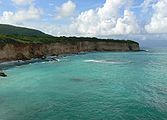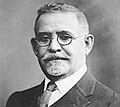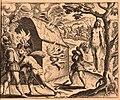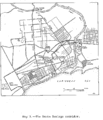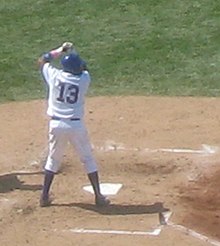Introduction
The Dominican Republic is a country on the island of Hispaniola in the Greater Antilles archipelago of the Caribbean Sea, bordered by the Atlantic Ocean to the north. It occupies the eastern five-eighths of the island, which it shares with Haiti, making Hispaniola one of only two Caribbean islands, along with Saint Martin, that is shared by two sovereign states. It is the second-largest nation in the Antilles by area (after Cuba) at 48,671 square kilometers (18,792 sq mi), and second-largest by population, with approximately 11.4 million people in 2024, of whom approximately 3.6 million live in the metropolitan area of Santo Domingo, the capital city. The Dominican people declared independence from Spain in November 1821. The colony of Santo Domingo was regionally divided with many rival and competing provincial leaders during the 1800s. Dominicans were often at war fighting against the French, Haitians, Spanish, or amongst themselves, resulting in a society heavily influenced by military strongmen. Santo Domingo attained independence as the Dominican Republic in 1844 when Dominican nationalists led an insurrection against the Haitians. Over the next decades, the Dominican Republic experienced several civil wars, battles against Haiti, and a brief return to Spanish colonial status, before permanently ousting the Spanish during the Dominican War of Restoration of 1863–1865. The U.S. occupied the Dominican Republic (1916–1924) due to threats of defaulting on foreign debts; a subsequent calm and prosperous six-year period under Horacio Vásquez followed. From 1930 the dictatorship of Rafael Leónidas Trujillo ruled until his assassination in 1961. Juan Bosch was elected president in 1962 but was deposed in a military coup in 1963. A civil war in 1965, the country's last, was ended by U.S. military intervention and was followed by the authoritarian rule of Joaquín Balaguer (1966–1978 and 1986–1996). Since 1978, the Dominican Republic has moved toward representative democracy. The Dominican Republic has the largest economy (according to the U.S. State Department and the World Bank) in the Caribbean and Central American region and is the seventh-largest economy in Latin America. Over the last 25 years, the Dominican Republic has had the fastest-growing economy in the Western Hemisphere – with an average real GDP growth rate of 5.3% between 1992 and 2018. GDP growth in 2014 and 2015 reached 7.3 and 7.0%, respectively, the highest in the Western Hemisphere. Recent growth has been driven by construction, manufacturing, tourism, and mining. The country is the site of the third largest (in terms of production) gold mine in the world, the Pueblo Viejo mine. (Full article...) Selected article -La Romana is a municipality and capital of the southeastern province of La Romana, opposite Catalina Island. It is one of the 10 largest cities in the Dominican Republic with a population estimated in 2010 at 130,426 within the city limits (metropolitan population: 214,109), of whom 127,623 are urban and 2,803 are rural. The name Romana comes from the word "Bomana", a name given by Indians to what is known today as Romana River. The modern La Romana International Airport was opened in 2000. The city is near several other cities, such as San Pedro de Macorís and the national capital, Santo Domingo de Guzmán. The city is a hub for a growing tourist industry with several nearby local resort spots, such as the beachfront Bayahibe, Dominicus, Casa de Campo, and the growing number of golf resorts that surround the area. (Full article...)General images -The following are images from various Dominican Republic-related articles on Wikipedia.
Selected picture -A baby humpback whale in the waters of the Dominican Republic
Selected biography -Neifi Neftali Pérez (/ˈneɪfi, ˈnɛfi/; Spanish: [ˈnejfi]; born June 2, 1973) is a Dominican former Major League baseball player. He was a switch hitter who threw right-handed. During his career, he played with the Colorado Rockies, Kansas City Royals, San Francisco Giants, Chicago Cubs, and Detroit Tigers. Pérez was originally signed by the Colorado Rockies in 1992. Frequently praised for his defensive skills, Pérez reached the major leagues in 1996 and became the Rockies' shortstop for good in 1997. Over the next three years, he scarcely missed a game and won a Gold Glove in 2000. In 2001, he was traded to the Kansas City Royals, where he also played in 2002. The trade proved to be unpopular with both teams, and Pérez joined the San Francisco Giants for 2003 and 2004. He lost his starting job during the 2004 season and was released during that year. Pérez then signed with the Chicago Cubs, whom he finished the season with and spent most of the next two years with. He was the Cubs' starting shortstop in 2005 but was used as a reserve player in 2006 before getting traded to the Detroit Tigers during the year. He finished his career in 2007 with the Tigers. As a Tiger, he turned a double play which saved Justin Verlander's no-hitter, but he also had a series of positive tests for amphetamines which effectively ended his career. (Full article...)Related portalsWikiProjects
Things to do
Associated WikimediaThe following Wikimedia Foundation sister projects provide more on this subject:
SourcesDiscover Wikipedia using portals | |||||||||||||||||||||||||
